OCZ Octane 128GB SSD Review
by Anand Lal Shimpi on December 28, 2011 12:27 AM ESTAn SSD State of the Union Update
I'm very pleased with the level of acceptance of SSDs today. When the X25-M first hit the market and even for the year that followed, any positive SSD recommendation was followed by a discussion of how many VelociRaptors you could RAID together for the same price as one SSD. Now we have an entire category of notebooks that come standard with some degree of solid state storage. End users are much more accepting of SSDs in general, aided by the fact that prices have finally dropped very close to the magical $1/GB marker (a boundary I expect us to finally cross by the end of 2012).
Today's SSDs are not only more prevalent than those we were reviewing just a couple of years ago, they're also a lot better. While the first SSDs still had difficulties competing with mechanical storage for sequential transfers, modern SSDs are several times faster even in the most HDD-friendly workloads. The implementation of technologies such as TRIM helps ensure the performance degradation issues of the very first drives are less likely to be encountered by anyone with a normal client workload.
Although it helped shape the client SSD business, Intel's drives are no longer the only option for performance and reliability. There are good, reliable SSDs from companies like Micron and Samsung that can easily hang with their Intel competitors. And if you're willing to live on the bleeding edge for the promise of the absolute best performance, there's always SandForce.
The client SSD space may not be mature, but I'm happy with the current state of things. With the exception of the ultra low price points, if you want an SSD, there's a solution on the market for you today.
Going forward, I'm not expecting a ton of change in the near term. Intel's Cherryville SSD has been delayed. This is the long awaited SandForce based drive from Intel. I suspect the delay has to do with Intel working through bugs in SandForce's firmware, but its efforts should hopefully make the platform more robust (although it remains to be seen if any of Intel's efforts are ported back into the general SF codebase).
In the first half of next year we'll see the first 20nm IMFT NAND shipping in client SSDs. The smaller transistor geometry will eventually pave the way for cheaper drives, although I wouldn't expect an immediate drop in prices. At the very least we'll see firmware updates enabling 20nm NAND support, although we may see the introduction of some new controllers as well. We're going to be pretty limited in terms of performance gains until ONFI 3.0 based controllers/NAND show up in early 2013. I expect the next 12 months to be more about driving enterprise SSDs and bringing down the cost of consumer drives.
The Topic At Hand: OCZ's Octane
Now for the reason we're all here today. Earlier this year OCZ acquired Indilinx, one of the first SSD controller makers to really make a splash in the enthusiast community. Ever since OCZ entered the SSD business it wanted to guarantee its independence by securing exclusive rights to a controller. OCZ initially did so by buying up all available inventory, first of Indilinx controllers, then of SandForce controllers. That strategy would only work for a (relatively) short period of time as the controller vendors sought to expand their market by selling chips to OCZ's competitors. A few slip ups on the roadmap and Indilinx was ripe for acquisition. OCZ stepped up to the plate and sealed the deal. Several months later, OCZ debuted its first drive based on an unreleased, exclusive Indilinx design: Octane.
Although Octane didn't set any performance records, it was competitive. Performance was definitely current gen, giving OCZ an in-house alternative to SandForce. There was just one issue: OCZ only sent out 512GB Octane review samples. SSDs get a good amount of their performance by executing reads/writes in parallel across multiple NAND devices. Higher capacities have more devices to read/write in parallel, and thus generally deliver the best performance. The greatest sales volume is of the lower capacity models - they're cheaper to own and NAND prices are falling quickly enough that investing in a 512GB drive rarely makes financial sense.
| OCZ Octane Lineup | |||||||
| 1TB | 512GB | 256GB | 128GB | ||||
| NAND Type | 25nm Intel Sync MLC | 25nm Intel Sync MLC | 25nm Intel Sync MLC | 25nm Intel Sync MLC | |||
| NAND | 1TB | 512GB | 256GB | 128GB | |||
| User Capacity | 953GiB | 476GiB | 238GiB | 119GiB | |||
| Random Read Performance | Up to 45K IOPS | Up to 37K IOPS | Up to 37K IOPS | Up to 37K IOPS | |||
| Random Write Performance | Up to 19.5K IOPS | Up to 16K IOPS | Up to 12K IOPS | Up to 7.7K IOPS | |||
| Sequential Read Performance | Up to 560 MB/s | Up to 535 MB/s | Up to 535 MB/s | Up to 535 MB/s | |||
| Sequential Write Performance | Up to 400 MB/s | Up to 400 MB/s | Up to 270 MB/s | Up to 170 MB/s | |||
| MSRP | TBD | $879.99 | $369.99 | $199.99 | |||
OCZ finally sent out a 128GB Octane, which I promptly put through our standard test suite.
The drive still uses sixteen IMFT synchronous NAND devices. In this case each package features 64Gb (8GB) of 25nm MLC NAND on a single die. You may remember from our original review of the 512GB Octane that the Indilinx Everest controller supports 8-channels, but pipelining read/write requests to multiple devices per channel is supported.
Gone from the Octane's PCB are the TI muxes that we found on the 512GB version. With the only difference between these drives being their capacity, it's likely that the muxes were used to switch between NAND die/packages. The 512GB version has 4x the number of NAND die than the 128GB version, and it's possible that the Everest controller is only capable of directly communicating with 16 or 32 die on its own. An external mux per channel would allow OCZ to scale capacities much further.
Other than the absent muxes and a change in PCB color, the 128GB Octane is no different than the original 512GB drive we reviewed. The drive does ship with a newer firmware revision:
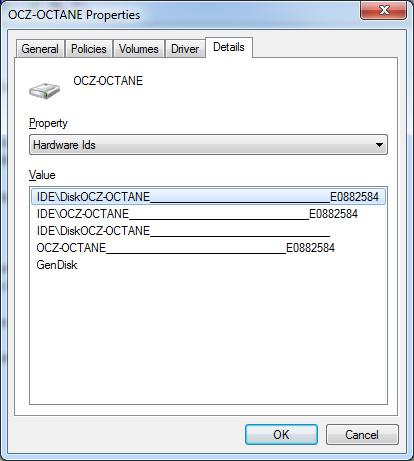
The updated firmware doesn't do much for performance, although it does apparently fix a number of bugs that existed in the previous version. I haven't seen any mass reports of significant issues with the Octane, although it is still pretty new. Let's hope the trend continues.
The Test
| CPU |
Intel Core i7 2600K running at 3.4GHz (Turbo & EIST Disabled) - for AT SB 2011, AS SSD & ATTO |
| Motherboard: |
Intel DH67BL Motherboard |
| Chipset: |
Intel H67 |
| Chipset Drivers: |
Intel 9.1.1.1015 + Intel RST 10.2 |
| Memory: | Corsair Vengeance DDR3-1333 2 x 2GB (7-7-7-20) |
| Video Card: | eVGA GeForce GTX 285 |
| Video Drivers: | NVIDIA ForceWare 190.38 64-bit |
| Desktop Resolution: | 1920 x 1200 |
| OS: | Windows 7 x64 |


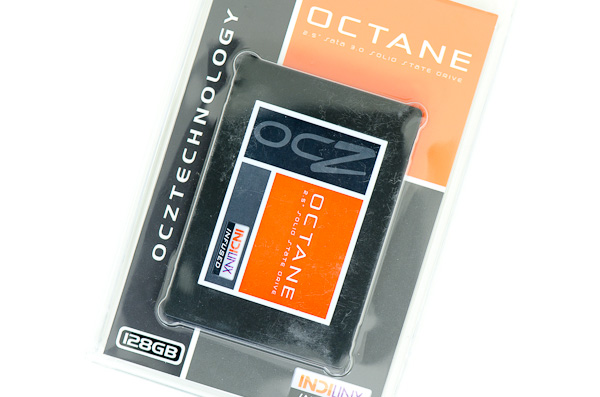
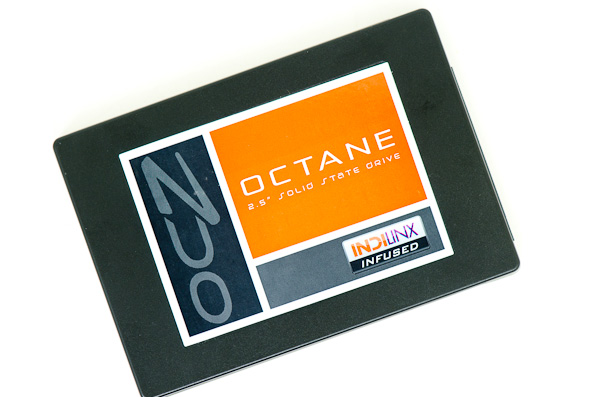
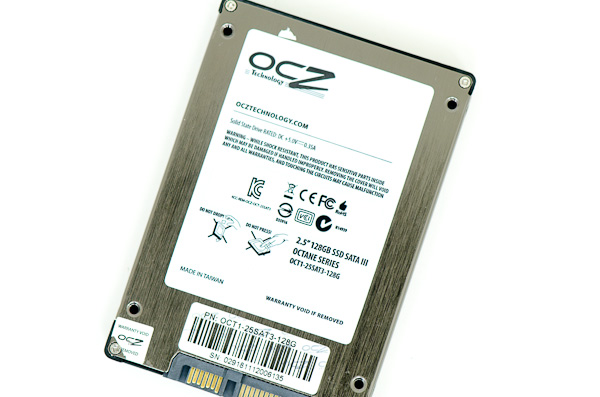
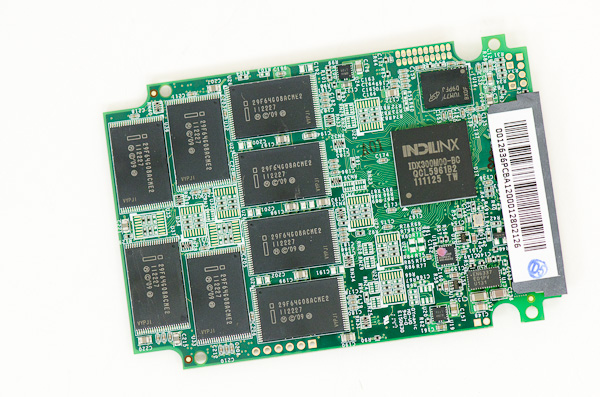
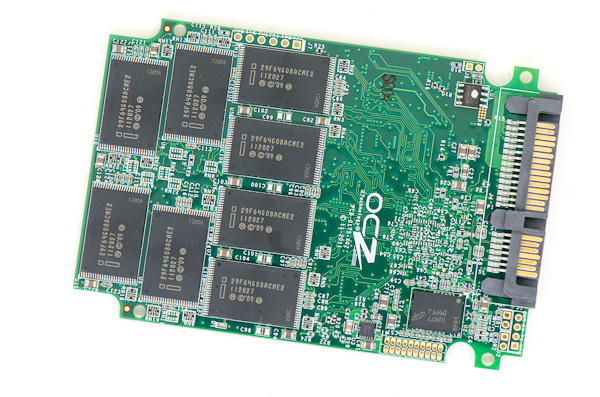








38 Comments
View All Comments
yogi2k - Wednesday, December 28, 2011 - link
I guess your education must have been bad, seeing how the internet is global and not American.billegge - Wednesday, December 28, 2011 - link
Here is where I stand: I am a software developer and I develop within VM's, and VM's are IO intensive when running more than one VM on the same drive - thus I will choose a sandforce drive and not the Octane for the que depth. However, my daughter uses a netbook in a consistent manner - a very light workload and i think the Octane would suffice for her however the price point of the Octane is too close to the price of a Sandforce so I would rather go with the sandforce. BUT, OCZ is going to put out a Petrol version at a much lower price point - in this case and considering my daughter is running a 5400 RPM drive the Petrol should give her a significant boost at a price I would be happy with. So... I would like to see some Petrol benchmarks - but really mostly I would like to here from a live user their "experience" of the drive rather than benchmarks.Morg. - Thursday, December 29, 2011 - link
Simple answer : your daughter does not need an ssd, quit trying to spend money for no reasons.If she can survive a netbook without requiring a hammer, I don't see why she'd need an SSD.
krazyderek - Wednesday, December 28, 2011 - link
Would have been great to see the samsung 830 128GB drive in the same chartsTHANK YOU for the performance over time analysis that was missing from the original 512GB review due to logistics. I read these reviews for personal interest but also with an eye on them for something that a lightweight server could benefit from (at work).
todlerix - Wednesday, December 28, 2011 - link
Am I alone in being sore at OCZ for their sleazy means of making money? (Change NAND resulting in performance loss without changing the SKU or informing their customers.)To counter the nearly guaranteed "But they changed their ways!"
They only came clean once they were busted. If they were never caught the practice would still be an on going.
(Prepare for a cliche.)
They were only sorry they were caught.
MrCromulent - Wednesday, December 28, 2011 - link
I won't be buying OCZ for a long, long time as well. Besides their questionable business practices, every single one of my 5 older Indilinx Barefoot drives failed within one year.Firmware upgrades usually take a few hours. I have to test 5-8 PCs until I find one that lets me boot the DOS image and flash the drives without cryptic error messages.
FunBunny2 - Wednesday, December 28, 2011 - link
-- The smaller transistor geometry will eventually pave the way for cheaper drivesGiven the past history of geometry drops, I don't thinks so, if maintaining performance is taken into account. We've seen significant increases in over-provisioning with drops so far. Given that we know the physics gets non-linearly worse for each drop, I'd be surprised if a 20nm SSD with comparable performance will be cheaper.
sheh - Wednesday, December 28, 2011 - link
Looks like even after TRIM the drive is writing somewhat slower than it was (159 -> 134 MB)?And is HD Tach inaccurate in reporting burst speeds? Some of them are slower than the average.
SanX - Thursday, December 29, 2011 - link
New Year of course is an excuse but not like in this case: that was worst ever publication about SSDs-bad set of drives was taken. The mix of SATA2 and 3 is like comparing apples and oranges. Well it was ok when we had rare SATA3 drives. Not anymore. If Corsair is shown here with SATA2, it has to be shown with SATA3 too because it looks bad in this paper.
-non-substantiated predictions about pricing. Do you time the market? Prices strictly depend on market conditions --if market will nosedive like in 3 years ago in Mar 2009 the prices will follow below production costs. For example the 3 years ago we've already seen flash memory at $1/GB and see them again at this price point only now.
-No serious critics. Almost like on sites which are inherently interested to sell any cr#p they review. If this will happen, that will be the end of former great Anandtech. OCZ could easily make write performance of this drive in par with 512GB version taking same amount of smaller capacity NAND chips -- no suggestions or in-deep discussions why it was not done.
Don't drink and drive, Anand.
And Happy New Year
Spoogie - Thursday, December 29, 2011 - link
This drive has AES and Automatic Encryption, which is required for any drive I'll buy given that SSDs cannot be erased with current consumer technology.http://www.ocztechnology.com/ocz-octane-sata-iii-2...
Thanks for the review.